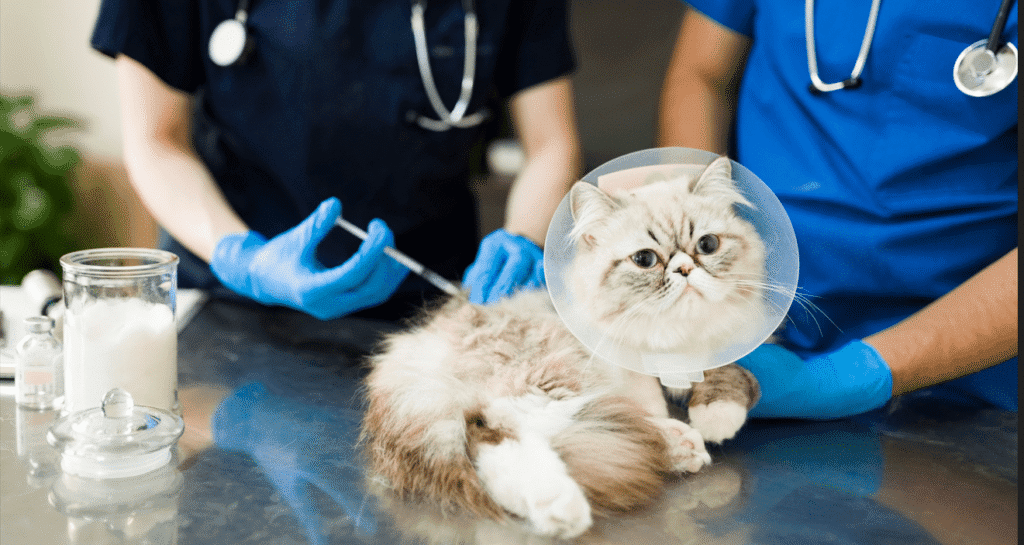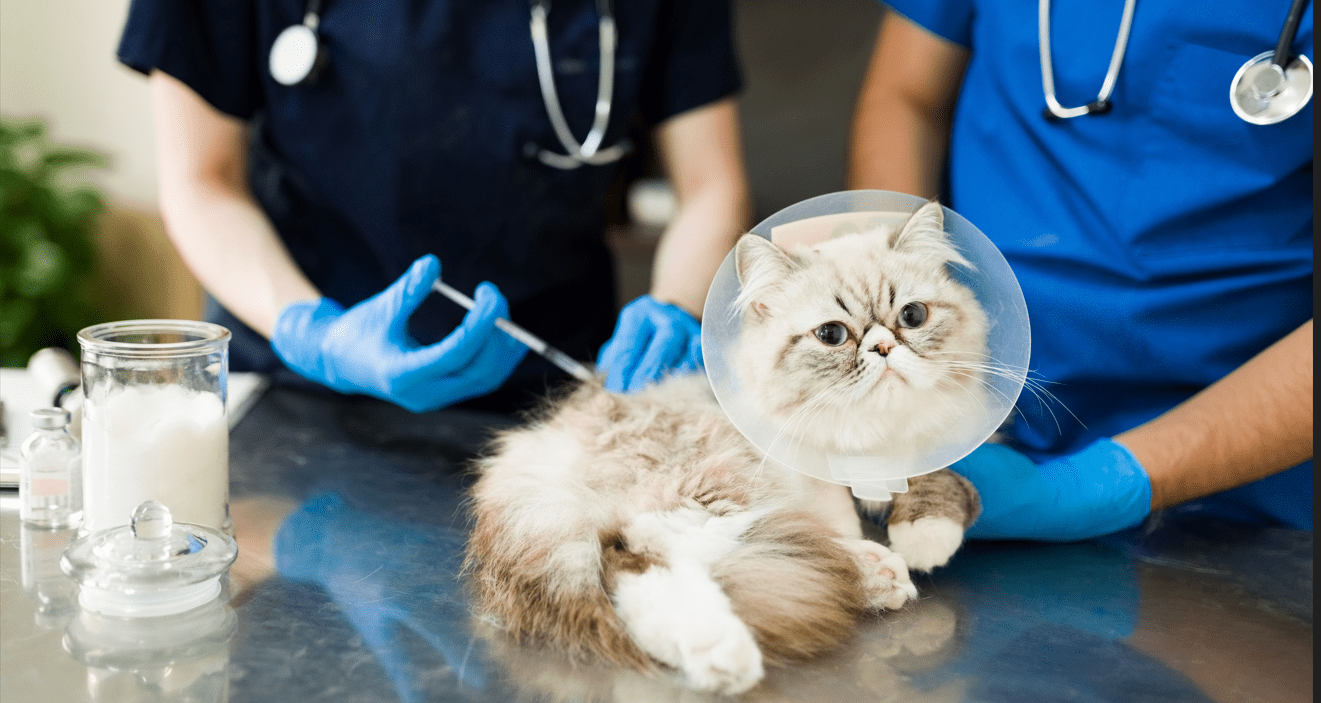Table of Contents
Core Vaccines to Protect Your Cat
As a lifelong cat owner, I’ve seen how even indoor cats can sneak out the door for just a minute and still face serious danger because the viruses that cause feline diseases like rhinotracheitis (FVR), panleukopenia (FPV), and calicivirus (FCV) are highly contagious, spread through contact with an infected object, and can survive on surfaces in the environment for up to a year.
That’s why the FVRCP Vaccine for Cats is one of the core vaccines your cat should receive, whether they are indoor or outdoor. It’s recommended for all cats and helps protect them from seriously falling ill due to these infectious conditions. Alongside FVRCP Vaccine for Cats the rabies vaccine is also required by law in most states, making it essential regardless of your cat’s lifestyle.
While shots may come with potential reactions or mild side effects, they rarely occur and are far less risky than your pet contracting a deadly virus. Trust me just one short time of exposure can put your furry friend at real risk, so make sure they are properly vaccinated.
When Should My Cat Get the FVRCP Shot?
The first FVRCP vaccine should be given to kittens between 6 and 8 weeks of age, starting a series of shots that continue every 3 to 4 weeks until they reach 16 to 20 weeks. This vaccination schedule builds strong protection against dangerous viruses like FHV, FCV, and FPL during their vulnerable early life. Afterward, another booster is recommended at one year, then every 3 years for the rest of their life to keep immunity strong.
For adult cats, the timing depends on their past vaccinations and the veterinarian’s recommendation. Importantly, this vaccine is not given to pregnant cats, and live vaccines require careful timing to avoid risks. Following this plan helps prevent your cat from contracting these illnesses and ensures a healthy, happy companion.
Conditions That The FVRCP Vaccine Protects Against
The FVRCP vaccine is an essential safeguard for your companion kitty, designed to protect against three highly contagious and life-threatening feline diseases. Each part of the vaccine targets a specific illness, as represented in its name: Feline Viral Rhinotracheitis (FVR), Feline Calicivirus (C), and Feline Panleukopenia (P). From personal experience, I’ve seen how this extremely effective vaccine can be a lifesaver, providing broad protection against these serious conditions that put countless cats at risk.
The three diseases, indicated by the letters F, C, and P at the end of the vaccine’s title, work together in the vaccine to protect your furry friend’s health comprehensively.
Feline Viral Rhinotracheitis (FHV-1)
Cats feline viral Rhinotracheitis caused by feline herpesvirus type-1 (FHV-1) is a species-specific infectious disease that affects both domesticated cats and wild cats. The virus spreads mainly through direct contact with virus particles found in saliva, discharges from the eyes and nose, or contaminated objects and surfaces. It attacks the upper respiratory tract diseases, including the windpipe, causing symptoms like fever, sneezing, inflamed eyes, inflamed nose, and discharge.
While healthy adult cats often experience mild symptoms lasting 5-10 days, the virus can remain dormant in the body and flare repeatedly, sometimes causing a longer duration of illness. More severe symptoms tend to occur in kittens, senior cats, and immune-compromised cats, who may suffer from depression, loss of appetite, severe weight loss, sores inside mouth, and emaciation.
The illness can last about six weeks or longer, often complicated by bacterial infections that worsen the condition. In fact, up to 80 to 90% of cats carry this disease in a dormant state and may flare up throughout their kitty’s lifetime. Recognizing early signs such as runny eyes and runny nose is critical to start cleaning up and help the infection clear up, protecting your beloved feline friends from persistent health issues.
Feline Calicivirus (FCV)
With both domestic cats and some exotic species, Feline Calicivirus (FCV) is a common virus that acts as a major cause of upper respiratory infections and oral disease. This highly contagious virus spreads through saliva, secretions from the eyes and nose, and also via airborne particles, urine, and feces from infected cats. Cats become susceptible through contact or environmental exposure to contaminated objects. Kittens and senior cats are especially vulnerable to this potentially fatal illness.
The usual symptoms include nasal congestion, sneezing, eye inflammation, and discharge which can be clear or yellow. Painful ulcers on the tongue, palate, and lips cause discomfort, leading to loss of appetite, weight loss, and fever. You may also notice enlarged lymph nodes, squinting, and lethargy as the infection worsens. FCV comes in different strains, some more dangerous than others. When untreated, it can result in serious conditions like pneumonia from fluid buildup in the lungs.
Affected cats may also develop joint pain and lameness, which adds to their suffering. From what I have seen, the FVRC vaccine plays a crucial role by protecting cats against FCV, feline rhinotracheitis, and other upper-respiratory infections. This vaccine significantly lowers the chance of severe illness and helps reduce the spread of this common virus, especially where many cats live close together.
Feline Panleukopenia (FPL)
Feline panleukopenia (FPL) is a serious virus and a common virus that attacks cats of any age, though it is especially fatal in kittens. This virus causes severe bone marrow damage and harms the lymph nodes and the cells lining intestines. Typical symptoms include high fever, loss of appetite, depression, lethargy, vomiting, severe diarrhea, nasal discharge, and dehydration.
The disease spreads mainly through direct contact with infected cats or by exposure to contaminated food, water dishes, objects, secretions, or feces. Many infected cats become virus carriers, spreading the infection rapidly, especially among unvaccinated kittens living in poor living conditions. Due to rapid progression, immediate medical attention is critical as death within 12 hours can occur.
There is no medication that directly provides virus killing, so treatment focuses on symptom management and preventing secondary infections caused by the weakened immune system. Severe cases may lead to shock, requiring intravenous fluid therapy and intensive nursing care. This illness is sometimes called distemper because of the severity and speed of infection. Proper vaccination with the FVRCV vaccine is essential to protect cats from exposure and to reduce the risks related to breed, living conditions, and other factors.
Risk of Reactions & Side Effects from FVRCP Vaccine

Side effects from vaccines in cats are generally unusual and mild, some pets may experience a slight fever or localized swelling at the injection site shortly after vaccination. In rare cases, more extreme reactions can develop within 48 hours, including symptoms such as hives, swelling around lips and eyes, itchiness, persistent fever, diarrhea, vomiting, breathing difficulties, or excessive sneezing.
If a cat shows signs of a severe reaction, it is critical to contact a vet immediately or visit an emergency animal hospital. Timely appointment and an accurate diagnosis are essential to address the pet’s condition effectively.
FVRCP Cat Vaccine Cost?
The cost of the FVRCP vaccine for a cat can vary widely, influenced by several key factors such as the age of the animal and whether the vaccine is part of a core vaccination package. Additionally, the brand of the live vaccine your veterinarian or vet chooses impacts pricing. From my experience, requesting a detailed cost estimate from your vet before the vaccination helps manage expectations and ensures tailored care for your pet.
FAQs
1. What is an FVRCP vaccine for cats?
The FVRCP vaccine for cats is a core vaccine that protects against three serious feline diseases: rhinotracheitis (FVR), calicivirus (FCV), and panleukopenia (FPV). It’s important for all cats, whether indoor or outdoor, to get this vaccine to keep them safe from these easily spreadable infections.
2. What happens if I don’t vaccinate my indoor cat?
Even indoor cats are at risk of contracting diseases like FVR, FCV, and FPV if they come into contact with contaminated surfaces or objects. Not vaccinating them exposes them to serious health risks.
3. What is the 3-in-1 vaccine for cats?
The 3-in-1 vaccine for cats is a single shot that helps protect your furry friend from three serious diseases: feline rhinotracheitis, calicivirus, and panleukopenia. It’s an essential vaccine for every cat, whether indoor or outdoor.
4. Can cats live without vaccines?
While some cats may survive without vaccines, they are at higher risk of contracting serious and potentially fatal diseases. Vaccines provide essential protection against common feline viruses.
5. Is FVRCP a killed virus?
Yes, the FVRCP vaccine often contains inactivated (killed) viruses or modified live viruses, depending on the brand. This helps the immune system safely develop protection without causing disease.
6. How does FVRCP work?
The FVRCP vaccine stimulates your cat’s immune system to produce antibodies against rhinotracheitis, calicivirus, and panleukopenia. These antibodies protect against future infections by recognizing and attacking these viruses.
